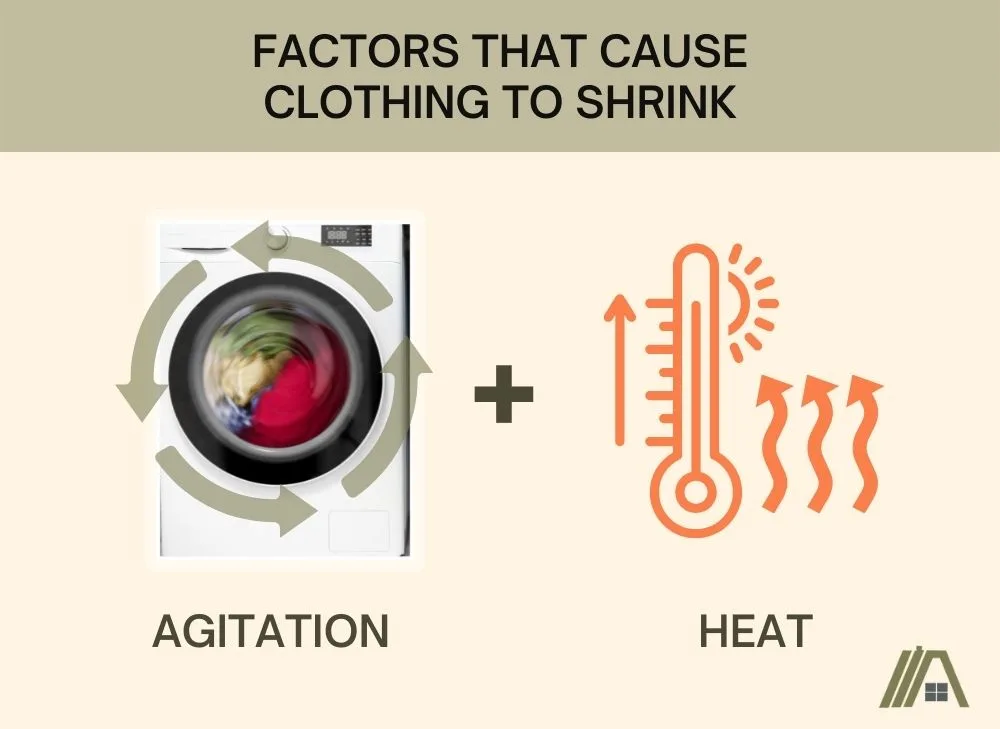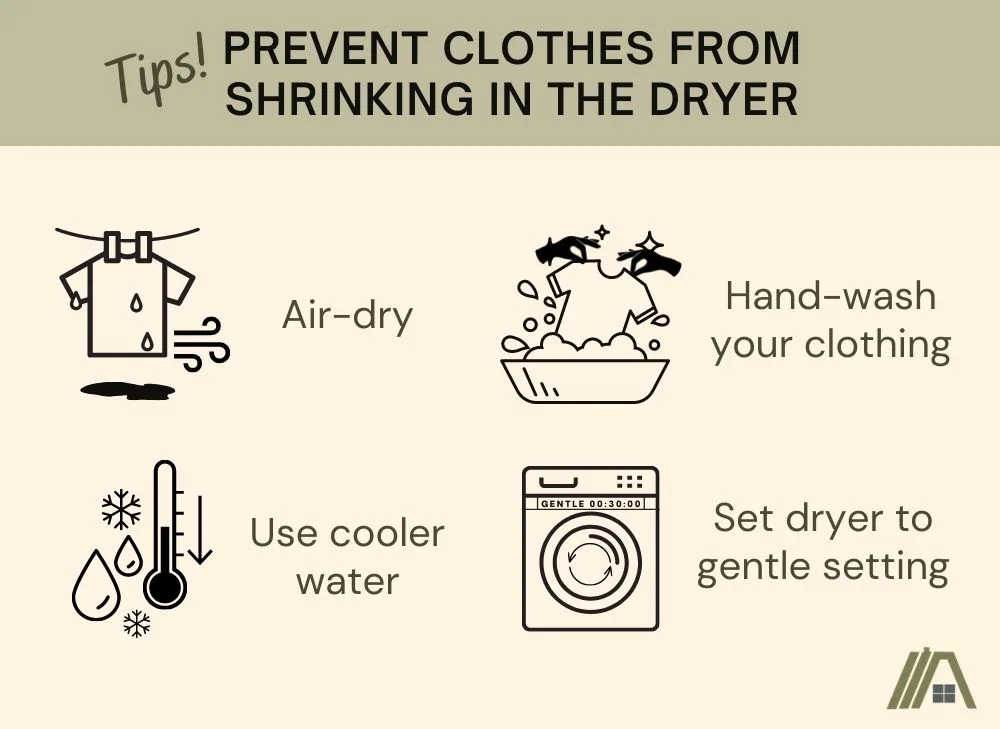I don’t know about you, but I’m no stranger to laundry accidents, such as reducing the size of a brand new linen dress into something I couldn’t wear. Hearing all the recent talk about how energy-efficient ventless dryers run at low temperatures, I couldn’t help but wonder if one could help prevent similar disasters.
As it turns out, heat isn’t the only thing that can lead to shrunken clothes! Therefore, not even ventless dryers can prevent all fabrics from shrinking. Let’s look at which fibers will not be safe and why.

Since ventless dryers, especially heat pump dryers, generally operate at lower temperatures than vented ones, they are less likely to shrink fibers sensitive to high temperatures, like cotton. However, materials that shrink primarily due to agitation, as most animal materials do, are still likely to shrink.
Why Do Clothes Shrink in the Dryer?
Many different types of clothing are prone to shrinkage, especially natural and animal fibers such as cotton, wool, and mohair.
However, contrary to popular belief, it isn’t always just heat that causes fabrics to shrink.
In the case of animal fibers, it is primarily agitation that causes shrinkage, meaning that both the tumbling motion of the dryer and the heat used to dry the clothing contribute to the reduction of size.
As for the more absorbent natural fibers like cotton or linen, it is, in fact, the heat that is the main issue when shrinkage comes into play, although agitation still contributes.
Tension is used on cotton during the process of creating clothing, and heat allows the tension held in the fibers to release. This release of tension is what causes materials like cotton to shrink as the fabric returns to its natural resting state.
Essentially, heat and agitation are both factors that cause clothing to shrink.

What Temperatures Cause Shrinkage?
Because various fabrics are made of different materials, each will react differently to varying degrees of heat.
Again, most man-made fabrics are not as prone to shrinking as natural fibers are. This is because many synthetic fabrics like polyester or acrylic are petroleum-based and require a much higher temperature for any reaction to occur.
That said, fabrics that do shrink will do so at different temperatures. Wool, for example, can shrink even when dried at only 86-104 °F (30-40 °C) since the agitation caused by tumbling also contributes to shrinkage.
Cotton clothing can shrink up to 20% when dried at 130 °F (54 °C) or higher! Fortunately, the amount of shrinkage that occurs can be greatly reduced by lowering washing and drying temps.
Since drying temperatures and resistance to agitation shrinkage can vary from fabric to fabric, it’s probably a good idea to look up specifics for the clothing that you have. That way, you will know exactly what adjustments to make to your washing routine to prevent potential mishaps.
Running Temperature of Dryers
Vented Dryers
Gas
Gas dryers are very efficient and dry laundry very quickly by using high heat.

Of all dryer types, gas dryers run at the highest temperatures. While an average dryer will run at around 125-135 °F (52-57 °C) on a low or medium setting, the high setting may reach up to around 170 °F (77 °C).
Gas dryers, being the type of dryer with the highest heat, will generally run at the higher end of these numbers.
Either way, given that natural fibers can shrink even when dried at only 86 °F (30 °C), it is very likely that shrinkage will occur in a gas dryer, even if the dryer runs on a lower setting.
Electric
Electric dryers, also being traditional vented dryers, tend to run at around 125-135 °F (52-57 °C) on lower heat settings.
Like gas dryers, many models may be able to run at slightly higher temps, but electric dryers do not typically reach temperatures as high as gas dryers do.
Furthermore, while some electric dryers may have some very low heat settings that will not cause any major shrinkage to fabrics like cotton, you should still be cautious when drying fabrics such as wool or cashmere that primarily shrink from agitation.
Condenser Dryers
Condenser dryers are a type of ventless dryer, so named because they collect the water that is removed from your wet laundry through condensation rather than venting it outside as steam.
These dryers typically operate at a maximum of around 158 °F (70 °C), though their average running temperatures are actually slightly lower than the average running temperatures of vented dryers.
Despite condenser dryers operating in a completely different manner than gas or electric dryers, their heat and tumble features are still going to be a problem when it comes to causing shrinkage.
Once again, these are not dryers you’ll want to risk drying any valued natural fiber clothing items in. Shrinkage is just as likely to occur in a condenser dryer as in a vented one.
Heat Pump Dryers
Heat pump dryers are another type of ventless dryer, like condenser dryers, though they operate quite differently. Because of this, they run at the lowest average temperature of all, only around 122 °F (50 °C).
When put on a low heat setting, they will almost certainly be safe for materials like cotton, which endure most of their shrinkage at 130 °F (54 °C) or higher. That said, you may still experience some shrinkage if the dryer is on a high or medium setting.
Even with heat pump dryers, fabrics that shrink from agitation are still at risk of shrinking, perhaps even more so.
Since heat pump dryers use lower temperatures, they also take longer to dry. The extended time tumbling around inside a heat pump dryer may actually cause the most shrinkage to animal fiber clothing.
Tips to Prevent Clothes Shrinking in the Dryer
Essentially, there is no dryer that is 100% safe for all shrinkable fabrics. However, there are still several ways to prevent or reduce clothing shrinkage!
The first is to simply air-dry clothing made from fabrics prone to shrinking.
Even when you’re in a bit of a rush, it shouldn’t hurt much to mostly air-dry, and then also pop your clothing into the dryer for 10-15 minutes on low heat just to finish up the job.
Secondly, it may help to wash your shrink-prone fabrics in cooler water in addition to drying them in cooler temps. Believe it or not, the heat and agitation in a washer can shrink them too!
Lastly, it’s always an option to hand-wash your clothing using cool or hand-hot water (not hotter than what is comfortable for your hands).
Lastly, your washer and dryer may each have a gentle or delicate setting rather than a tumble-dry; if so, make sure to use that to reduce any friction that can cause shrinking!

Sources
https://www.ahs.com/home-matters/quick-tips/keep-your-clothes-from-shrinking-in-laundry/
https://www.beko.co.uk/support/faqs/tumble-dryers/differences-between-heat-pump-and-condenser-dryer
https://www.blog.laundrycare.biz/post/laundry-shrinkage-prevention
https://blog.rentacenter.com/prevent-clothes-from-shrinking-in-dryer/
https://cleanandtidyliving.com/does-washing-at-60-shrink-clothes/
https://energized.edison.com/stories/understanding-different-washer-dryer-settings
https://www.hunker.com/12003256/the-maximum-temperature-for-a-clothes-dryer
https://www.pushplinen.com/blog/why-cotton-shrink-the-best-practices-to-care-cotton-shrinking/
https://www.scienceabc.com/eyeopeners/clothes-shrink-wash-cotton-denim-unshrink-felting.html
https://www.thespruce.com/why-clothes-shrink-in-the-laundry-2146152

